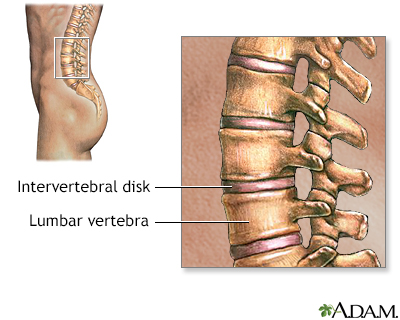Lumbosacral spine CT
Spinal CT; CT - lumbosacral spine; Low back pain - CT; LBP - CT
A lumbosacral spine CT is a computed tomography scan of the lower spine and surrounding tissues.
Images





I Would Like to Learn About:
How the Test is Performed
You will be asked to lie on a narrow table that slides into the center of the CT scanner. You will need to lie on your back for this test.
Once inside the scanner, the machine's x-ray beam rotates around you.
Small detectors inside the scanner measure the amount of x-rays that make it through the part of the body being studied. A computer takes this information and uses it to create a number of images, called slices. These images can be stored, viewed on a monitor, printed on film or saved on a disk. Three-dimensional models of organs can be created by stacking the individual slices together.
You must be still during the exam, because movement causes blurred images. You may be told to hold your breath for short periods of time.
In some cases, an iodine-based dye, called contrast, may be injected into your vein before images are taken. Contrast can highlight specific areas inside the body, which creates a clearer image.
In other cases, a CT of the lumbosacral spine is done after injecting contrast dye into the spinal canal during a lumbar puncture to further check for compression on the nerves. This is called a CT myelogram.
The scan usually lasts a few minutes.
How to Prepare for the Test
You should remove all jewelry or other metal objects before the test. This is because they may cause inaccurate and blurry images.
If you do need a lumbar puncture, you may be asked to stop your blood thinners or nonsteroidal anti-inflammatory drugs (NSAIDs) several days before the procedure. Check with your health care provider ahead of time.
How the Test will Feel
The x-rays are painless. Some people may have discomfort from lying on the hard table.
Contrast may cause a slight burning sensation, a metallic taste in the mouth, and a warm flushing of the body. These sensations are normal and usually go away within a few seconds.
Why the Test is Performed
CT rapidly creates detailed pictures of the body. A CT of the lumbosacral spine can evaluate fractures and changes in the spine, such as those due to arthritis or deformities.
What Abnormal Results Mean
CT of the lumbosacral spine may reveal the following conditions or diseases:
- Cyst
- Herniated disk
- Spinal stenosis
- Infection
- Cancer that has spread to the spine
- Osteoarthritis
- Osteomalacia (softening of the bones)
- Pinched nerve
- Tumor
- Vertebral fracture (broken spine bone)
Risks
The most common type of contrast given into a vein contains iodine. If a person with an iodine allergy is given this type of contrast, then hives, itching, nausea, breathing difficulty, or other symptoms may occur.
If you have kidney problems, diabetes or are on kidney dialysis, talk to your provider before the test about your risks of having contrast studies.
CT scans and other x-rays are strictly monitored and controlled to make sure they use the least amount of radiation. The risk associated with any individual scan is small. The risk increases when many more scans are performed.
In some cases, a CT scan may still be done if the benefits greatly outweigh the risks. For example, it can be more risky not to have the exam if your provider thinks you might have cancer.
Pregnant or breastfeeding women should consult their provider about the risk of CT scans to the baby. Radiation during pregnancy can affect the growing baby, and the dye used with CT scans can enter breast milk.
Related Information
CT scanCyst
Tumor
Herniated disk
Broken bone
Osteoarthritis
Osteomalacia
References
Reekers JA. Angiography: principles, techniques and complications. In: Adam A, Dixon AK, Gillard JH, Schaefer-Prokop CM, eds. Grainger & Allison's Diagnostic Radiology. 7th ed. Philadelphia, PA: Elsevier; 2021:chap 78.
Van Thielen T, van den Hauwe L, Van Goethem JW, Parizel PM. Current status of imaging of the spine and anatomical features. In: Adam A, Dixon AK, Gillard JH, Schaefer-Prokop CM, eds. Grainger & Allison's Diagnostic Radiology. 7th ed. Philadelphia, PA: Elsevier; 2021:chap 47.
BACK TO TOPReview Date: 8/27/2024
Reviewed By: C. Benjamin Ma, MD, Professor, Chief, Sports Medicine and Shoulder Service, UCSF Department of Orthopaedic Surgery, San Francisco, CA. Also reviewed by David C. Dugdale, MD, Medical Director, Brenda Conaway, Editorial Director, and the A.D.A.M. Editorial team.

Health Content Provider
06/01/2025
|
A.D.A.M., Inc. is accredited by URAC, for Health Content Provider (www.urac.org). URAC's accreditation program is an independent audit to verify that A.D.A.M. follows rigorous standards of quality and accountability. A.D.A.M. is among the first to achieve this important distinction for online health information and services. Learn more about A.D.A.M.'s editorial policy, editorial process and privacy policy. A.D.A.M. is also a founding member of Hi-Ethics. This site complied with the HONcode standard for trustworthy health information from 1995 to 2022, after which HON (Health On the Net, a not-for-profit organization that promoted transparent and reliable health information online) was discontinued. |
The information provided herein should not be used during any medical emergency or for the diagnosis or treatment of any medical condition. A licensed medical professional should be consulted for diagnosis and treatment of any and all medical conditions. Links to other sites are provided for information only -- they do not constitute endorsements of those other sites. © 1997- 2025 A.D.A.M., a business unit of Ebix, Inc. Any duplication or distribution of the information contained herein is strictly prohibited.
